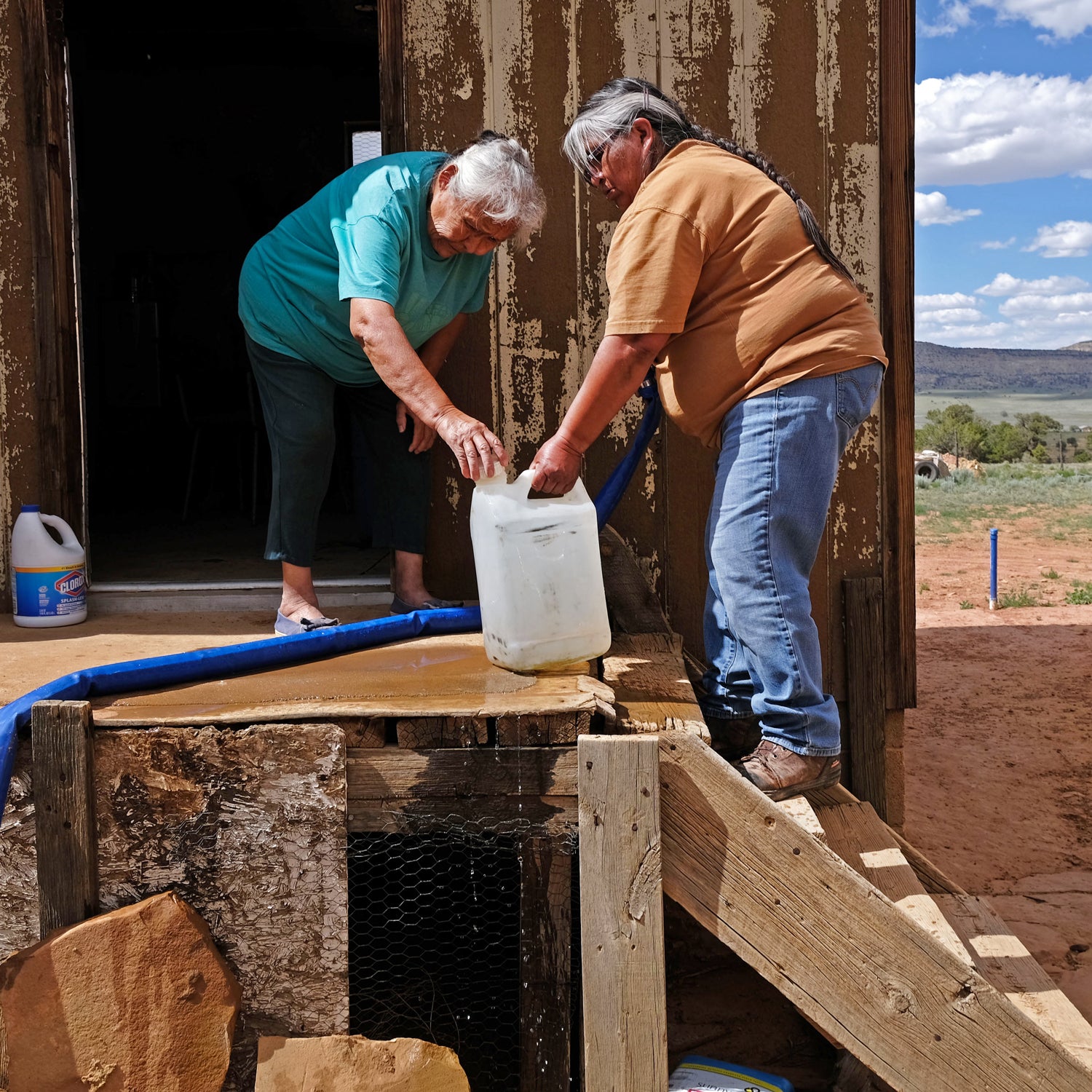“Wash your hands” and “stay home” have been the biggest public-health directives of the novel coronavirus pandemic. But what if you can’t? What if you have to leave home to draw water from a public tap that’s hours away��just to have enough to drink and cook with? Or if you’re trying to draw from a well that’s drying up from overuse and climate change��and might also be tainted ?
That’s the reality across much of the Navajo Nation, according to Cindy Howe, a project manager for the ,��which brings wells, water trucks, and plumbing to the reservation. The pandemic has hit��the Navajo Nation, which covers a 25,000-square-mile swath of the Four Corners region of the Southwest,��: by May 24, there were 4,658 reported cases and 165��deaths in a population of 173,000, the highest known infection rate anywhere in the country, including New York City.��
The Navajo Nation is particularly vulnerable to the coronavirus because it lacks sufficient��resources and infrastructure that most of the U.S. takes for granted: roads, electricity, internet to help spread public-health information, and��hospitals. The crisis has been��exacerbated by tight living quarters, and there are�� of health issues, like asthma, cancer,��and cardiovascular disease, among residents. All of those problems��are tied on some level to federal neglect or exclusion from resources��and stalled or missing funding.��Most recently,��$600 million in ��was��delayed by more than a month; the money finally arrived in early May.��
In the Navajo Nation, access to water is a big piece of both the COVID-19 crisis and long-standing��historical injustice. More than a third of the population doesn’t have access to running water, thanks to a combination of American water management that doesn’t respect tribal water rights��and a widespread lack of the infrastructure necessary to bring water to everyone on the reservation. The average American uses , but some on the Navajo Nation get by on just two or three gallons a day for eating, cooking, and cleaning. As the coronavirus spreads through their lands, the need for clean water—always a matter of life or death—has become even more life-threatening.
Currently, nonprofits and volunteers are distributing water to help residents access enough��and to encourage��social distancing. Howe says they’ve received hundreds of thousands of gallons of donated water, and her organization is coordinating with local fire departments and chapter governments to get it to centralized locations. They’re targeting senior centers and relying on police departments to��help distribute water and information. But the��coronavirus is still spreading��there, in part because people cannot stay home and self-isolate��when they have to travel��to get water to survive. And��it’s impossible to sustain crisis-level support forever—donating bottled water is, of course, a stopgap and not a solution.��
How is it possible that people in America are unable to wash their hands at the same time that people in, say, Phoenix or Los Angeles are filling residential swimming pools? There are two limiting factors when it comes to safe water access: quantity and quality.��The��Navajo lack��both,��mostly due to a legacy of colonialism��that led to decades of complicated legal battles��and the tribal government’s exclusion from federal and state water projects.��
Since the signing of the Constitution—which considers tribes to be sovereign nations—the U.S. government has made Native tribes walk a tricky line of sovereignty: they exist within the bounds of the country’s laws and resources in some instances but��independently in others. The�� onto reservations��led to a sustained imbalance��of��power between��the federal government��and tribal nations. That’s particularly true when it comes to water: treaties promised tribal nations water rights, but the federal government later excluded them from most national negotiations and infrastructure projects that would have made it possible for them to actually access water.��
For instance, the 1908 Winters Doctrine guaranteed federally reserved water rights to tribal nations, including the Navajo. Those rights, the doctrine said, would date back to the founding of their reservations—which is important, because in the��western U.S., water rights are given based on “prior appropriation,” meaning that parties with the oldest rights get their water first. The Navajo Nation,��whose reservation was established in��1868, should be��at the front of the line.
But the Navajo,��along with all of the region’s other tribes,��were left out of major water-policy negotiations, notably the�� in the 1920s, considered the law of the river in the Southwest.��The tribes say that��was a breach of their treaties, respect for their sovereignty, and the human rights of people on the reservations,��and they’re fighting with the Bureau of Reclamation to be a part of future negotiations.��Although those rights are technically protected by the federal government, the Navajo have��to battle��for them state by state—and they can’t legally use the water until those cases resolve in their favor. Some cases, like one over water rights to the Little Colorado River, have been in court for��.��
Meanwhile, the water crisis that has��existed a century too long is making the��pandemic within the Navajo’s borders even more deadly.
It is not an isolated injustice: there are currently��574��federally recognized tribes in the U.S., and as of 2019, only 40 of them have��reached water-rights settlements with the government.��(In 2016, the Indian Health Service estimated that it would cost $2.7 billion to provide water and sanitation infrastructure to all homes on reservations.)��A lack of running water is particularly problematic for people living in the arid Southwest, however—and while��the Navajo spent decades in court fighting for��water that��the Winters Doctrine says is already theirs by right,��they and other tribes were left out of public-works projects that watered the rest of the West.��
Through the middle of the 20th century, massive amounts of federal funding went into public water projects, such as the Hoover Dam. But the attitude about spending federal money on big public works has changed in recent years: in 1977, 63 percent of total capital spending for water and wastewater systems came from federal agencies, while that figure is 9��percent today. Across the country, aging infrastructure is way��, and places like the Navajo Nation that were initially left behind��are slipping even further back.��
To make matters even worse, we’ve already��. States and tribal nations alike have been legally promised water at a rate that is logistically impossible, especially now that climate change is��. Even if the Navajo��do finally get all their water rights approved in court, they may not be able to access all of it if there’s an insufficient supply in the streams or reservoirs that fuel the Southwest’s water systems.
As the number of coronavirus cases on the reservation continues to grow, the Navajo Nation plans��to allocate the $600 million it ��to address immediate public-health needs while also staving off the scale of future crises by some resources to water infrastructure. People have had to get creative: in some places, that means extending water pipes; in others, it means new��shared wells, bigger storage tanks, or�� for hauling water.��
Of course, it’s both physically and economically difficult to string a municipal water system across a sparsely populated reservation roughly��the size of West Virginia. It’s also dangerous to sink wells in an arid area where surface water and aquifers are already depleted from drought and industry, and where the groundwater in some areas has been contaminated by numerous��abandoned uranium mines. But the coronavirus has made it even clearer��that these people��have to try.
The outbreak and death toll on the Navajo Nation have��drawn ��to the much bigger public-health problem that exists��there. That can’t stop just because the CARES Act money has arrived. “We need to get these people hooked up to water lines, no matter the cost,” Howe says.��
Right now, she says,��the Navajo Nation��needs��additional central locations where people can collect��water.��It needs bigger storage tanks. Eventually, everyone on the reservation should have access to running water, even if it’s hugely expensive, to��proactively prevent devastation that might result from future pandemics. Plus, it was promised to them.
In dry places like the West, equity and the right to life are tied to water. The coronavirus pandemic is exposing the long-standing atrocity of holding tribal nations to different standards than U.S. settlements—and of systemically neglecting a human right, the right to water, within American borders.��


